Comparative Essay Writing: Methods and Examples
| Danielle McLeod
Danielle McLeod
Danielle McLeod is a highly qualified secondary English Language Arts Instructor who brings a diverse educational background to her classroom. With degrees in science, English, and literacy, she has worked to create cross-curricular materials to bridge learning gaps and help students focus on effective writing and speech techniques. Currently working as a dual credit technical writing instructor at a Career and Technical Education Center, her curriculum development surrounds student focus on effective communication for future career choices.
Writing effective comparative essays requires strategic techniques and thoughtful consideration of common pitfalls. A comparative essay explores the similarities and differences between subjects, allowing the writer to draw conclusions related to the topics of the material.
This article outlines key strategies, such as using transitions, incorporating evidence, and maintaining a formal tone. It also identifies mistakes to avoid, like failing to establish a clear basis for comparison or providing a superficial analysis.
The article emphasizes the importance of revising your comparative essay. This process enables you to refine your analysis, strengthen your arguments, and enhance the overall quality of your work. Incorporating feedback from peers or instructors can elevate your comparative essay and communicate your unique insights more effectively.
Whether you are a student or a professional writer, this guidance can help you craft comparative essays that captivate and inform your audience. Let’s explore the essentials of comparative analysis to enhance your writing prowess.

What is a Comparative Essay?

A comparative essay is a form of academic writing that examines and analyzes two or more subjects, identifying their similarities and differences. This type of essay allows students to develop critical thinking skills by evaluating and contrasting various topic elements.
For example, a comparative analysis of the Roman Empire and the Aztec Empire might make a good history class topic. In contrast, a comparative study of the Harlem Renaissance and the Chicano Art Movement would make a good art class focus.
Types of Comparative Methods
There are two main methods of structuring a comparative essay: the block method and the point-by-point method.
Block Method
- In the block method , you discuss each subject separately.
- You spend one or more paragraphs focusing on the first subject, then move on to the second subject.
- This allows you to go into more detail about each subject before comparing.
- The block method is good when the subjects you’re comparing have many differences or when you want to establish a strong foundation for your comparison.
Point-by-Point Method
- The point-by-point method jumps back and forth between the two subjects.
- In each paragraph, you address a specific point of comparison or contrast between the subjects.
- This structure encourages you to compare the subjects directly, clearly highlighting their similarities and differences.
- The point-by-point method works well when the subjects share clear, significant points of comparison, allowing you to explore their differences and similarities efficiently.
Why are Comparative Essays Important?
Comparative essays are an important part of academic writing because they encourage students to engage in deeper analysis, identify meaningful connections, and better understand the subjects being explored.

By comparing and contrasting different concepts, ideas, or phenomena, students can develop a well-rounded perspective and strengthen their ability to think critically.
What Should You Consider When Selecting Topics for Comparison?
When choosing topics for a comparative essay, it’s important to select subjects with some common ground but distinct differences. This will allow you to conduct a meaningful analysis and draw insightful conclusions. Consider factors such as the subjects’ historical context, cultural influences, or underlying themes to ensure a productive comparison.
For example, using the Block Method, you might do the following;
- Comparing the education systems in the United States and Canada
- Analyzing the differences between classic literature and modern young adult novels
- Contrasting the architectural styles of Gothic cathedrals and Renaissance palaces
In a block method essay on these topics, the writer would devote one or more paragraphs to thoroughly describing and analyzing the first subject (e.g., the US education system, classic literature, Gothic cathedrals) before moving on to discuss the second subject (e.g., the Canadian education system, young adult novels, Renaissance palaces). This would allow the reader to fully understand each topic before the comparative analysis is presented.
Using the Point-by-Point Method might be best used with these topics:
- Comparing the use of symbolism in Ernest Hemingway’s “The Old Man and the Sea” and F. Scott Fitzgerald’s “The Great Gatsby.”
- Contrasting the political ideologies of Abraham Lincoln and Theodore Roosevelt
- Analyzing the similarities and differences in the marketing strategies of Coca-Cola and Pepsi
In a point-by-point comparative essay, the writer would alternate between the two subjects in each paragraph, directly comparing and contrasting specific elements (e.g., how symbolism is used, political views, and marketing tactics). This would encourage a more integrated analysis of the similarities and differences between the subjects.
How Can You Brainstorm for a Comparative Essay?
To begin brainstorming for a comparative essay, start by creating a Venn diagram to visually organize the similarities and differences between your chosen topics. This can help you identify key points of comparison and contrast, which will form the foundation of your essay.

Additionally, consider writing down any questions or observations that arise during this process, as they may guide your subsequent research and analysis.
How Should You Formulate a Thesis Statement for a Comparative Essay?
A thesis statement is a one- or two-sentence summary that conveys a comparative essay’s main argument, focus, or purpose. It provides the reader with an overview of the essay’s central claim, which the rest of the paper will work to develop and support.
Your comparative essay’s thesis statement should clearly explain the central argument or insight that your analysis will explore. This statement should go beyond simply identifying the subjects being compared and instead make a substantive claim about the relationship between them. A strong comparative essay thesis will establish the basis for your comparative analysis and provide a roadmap for the rest of your essay.
For example, using the examples mentioned above, consider these options:
- “Classic literature and modern young adult novels differ greatly in their thematic depth, complexity of characterization, and use of literary devices, though both genres can provide valuable insights into the human experience.”
- “Gothic cathedrals and Renaissance palaces represent vastly contrasting architectural styles, with Gothic structures emphasizing verticality, pointed arches, and religious symbolism, while Renaissance palaces showcase classical proportions, ornate facades, and secular grandeur.”
- “Ernest Hemingway’s ‘The Old Man and the Sea’ and F. Scott Fitzgerald’s ‘The Great Gatsby’ both employ symbolic imagery to explore themes of the human condition, but they do so in strikingly different ways that reflect the author’s distinct writing styles and philosophical perspectives.”
- “Though Abraham Lincoln and Theodore Roosevelt held vastly different political ideologies, with Lincoln championing a strong federal government and Roosevelt advocating for a more progressive, regulatory approach, both presidents played pivotal roles in shaping the course of American history.”
What Strategies Should You Employ When Writing Comparative Essays?

When writing a comparative essay, it’s important to employ various strategies to effectively communicate your analysis. This may include using transition words and phrases to establish connections between ideas, incorporating relevant examples or evidence to support your claims, and maintaining a formal, academic tone throughout your writing.
Additionally, consider incorporating a Venn diagram or other visual aids to enhance your comparative analysis.
Strategies for Comparative Essays
To recap, use the following strategies in your work to help organize and structure your essay:
Use Effective Transitions
- Words/phrases like “in contrast,” “on the other hand,” “similarly,” “conversely,” etc.
- Help establish clear connections between ideas and comparisons.
Provide Relevant Examples and Evidence
- Draw from the subjects being compared to support your claims
- Use specific details, quotes, or data to strengthen your analysis
Maintain a Formal, Academic Tone
- Avoid casual or conversational language
- Focus on objective, analytical writing
Incorporate Visual Aids (if appropriate)
- Venn diagrams, tables, or other graphics can effectively illustrate comparisons
- Help the reader visualize the relationships between the subjects
Structure Logically
- Use either the block method or point-by-point organization
- Ensure a clear, coherent flow of ideas
Address Counterarguments or Limitations
- Acknowledge and respond to potential objections or alternative perspectives.
- Demonstrates depth of understanding
Which Mistakes Should You Be Careful of in Comparative Essay Writing?
Here are some examples to illustrate the common mistakes to avoid when writing comparative essays:
Failing to establish a clear basis for comparison
- Attempting to compare the plot of a novel to the musical score of an opera without explaining the relevance of that comparison
- Contrasting two political ideologies without defining the key criteria being used to evaluate them
Neglecting to address significant differences or similarities
- Comparing the leadership styles of two presidents but failing to discuss their differing approaches to domestic or foreign policy
- Analyzing the architectural features of Gothic cathedrals and Renaissance palaces without acknowledging their shared use of symmetry and classical proportions
Providing a superficial or unbalanced analysis
- Dedicating a single paragraph to analyzing the complex socioeconomic factors that shaped the development of two education systems
- The majority of the essay focused on the differences between the two subjects while only briefly mentioning their similarities.
Relying too heavily on plot summary or description
- Retelling the narratives of two novels in detail without delving into a comparative analysis of their themes, character development, or stylistic elements
- Extensively describing the physical attributes of two historical buildings without explaining how those features reflect the broader architectural movements.
Lacking a cohesive and logical organizational structure
- Jumping back and forth between discussing the two subjects without a clear basis for the order or flow of ideas
- Using the block method but failing to create a smooth transition between the sections devoted to each subject
Incorporating specific, relevant examples for each of these potential pitfalls can help illustrate the importance of avoiding them in comparative essay writing. These tips can help you when you just wish you could ask something to “ write my essay for me .”
Why is Revising Your Comparative Essay Crucial?

Revising your comparative essay is always considered an important step in the writing process, as it allows you to refine your analysis, strengthen your arguments, and ensure the overall explanation of connections and effectiveness of your essay.
During the revision stage, consider seeking feedback from peers or instructors. Their perspectives can help you identify areas for improvement and enhance the quality of your comparative essay.
Reasons to Revise Comparative Essays
Refine Your Analysis
- Example: Upon revision, you realize your comparison of two political ideologies lacks nuance and fails to acknowledge the complexities within each position. You then expand your analysis to provide a more nuanced and balanced perspective.
Strengthen Your Arguments
- Example: During revision, you identify gaps in your supporting evidence for a key point contrasting the marketing strategies of two rival companies. You then incorporate additional data and examples to bolster your comparative claims.
Ensure Coherence and Organization
- Example: In reviewing your essay, you recognize that your use of the point-by-point method is causing your comparisons to feel disjointed. You then reorganize your essay to follow a more cohesive block structure, improving the overall flow of ideas.
Incorporate Peer/Instructor Feedback
- Example: After receiving feedback from your instructor, you realize your comparison of two literary works does not adequately address a significant thematic similarity. You then revise the essay to incorporate this overlooked element into your analysis.
Enhance the Overall Quality
- Example: During the revision process, you identify opportunities to improve the clarity and precision of your language, ensuring your comparative essay communicates your insights effectively to the reader.
A comparative essay is a valuable academic writing exercise that encourages critical thinking, in-depth analysis, and the development of essential written communication skills. By mastering the structure, thesis formulation, and writing strategies associated with comparative essays, students can enhance their ability to engage in thoughtful, well-reasoned comparisons and effectively convey their research, discoveries, and opinions to their audience.
Grammarist is a participant in the Amazon Services LLC Associates Program, an affiliate advertising program designed to provide a means for sites to earn advertising fees by advertising and linking to Amazon.com. When you buy via the links on our site, we may earn an affiliate commission at no cost to you.
2024 © Grammarist, a Found First Marketing company. All rights reserved.
Comparing and Contrasting: A Guide to Improve Your Essays

By Walter Akolo
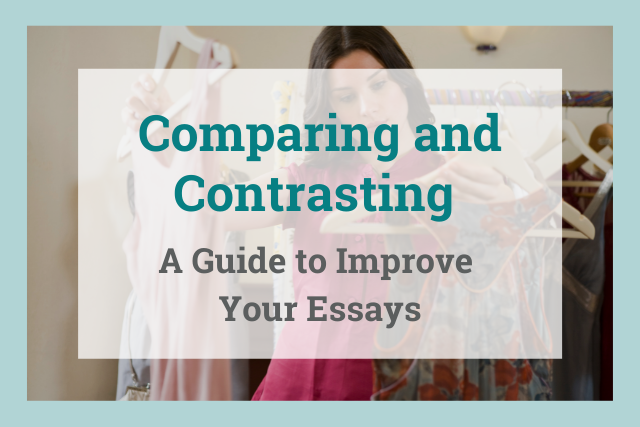
Essays that require you to compare and contrast two or more subjects, ideas, places, or items are common.
They call for you to highlight the key similarities (compare) and differences (contrast) between them.
This guide contains all the information you need to become better at writing comparing and contrasting essays.
This includes: how to structure your essay, how to decide on the content, and some examples of essay questions.
Let’s dive in.
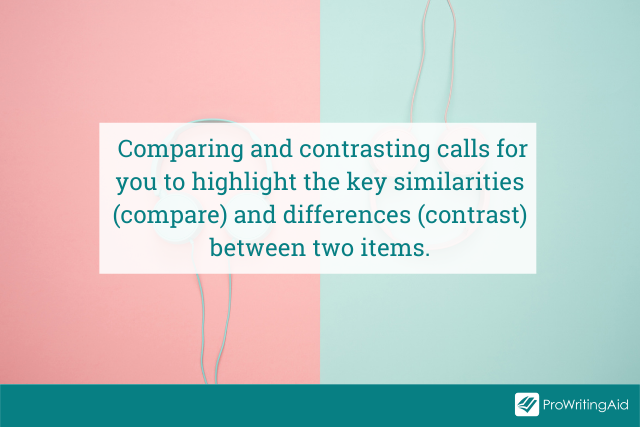

What Is Comparing and Contrasting?
Is compare and contrast the same as similarities and differences, what is the purpose of comparing and contrasting, can you compare and contrast any two items, how do you compare and contrast in writing, what are some comparing and contrasting techniques, how do you compare and contrast in college level writing, the four essentials of compare and contrast essays, what can you learn from a compare and contrast essay.
At their most basic, both comparing and contrasting base their evaluation on two or more subjects that share a connection.
The subjects could have similar characteristics, features, or foundations.
But while a comparison discusses the similarities of the two subjects, e.g. a banana and a watermelon are both fruit, contrasting highlights how the subjects or items differ from each other, e.g. a watermelon is around 10 times larger than a banana.
Any question that you are asked in education will have a variety of interesting comparisons and deductions that you can make.
Compare is the same as similarities.
Contrast is the same as differences.
This is because comparing identifies the likeness between two subjects, items, or categories, while contrasting recognizes disparities between them.
When you compare things, you represent them regarding their similarity, but when you contrast things, you define them in reference to their differences.
As a result, if you are asked to discuss the similarities and differences between two subjects, you can take an identical approach to if you are writing a compare and contrast essay.
In writing, the purpose of comparing and contrasting is to highlight subtle but important differences or similarities that might not be immediately obvious.
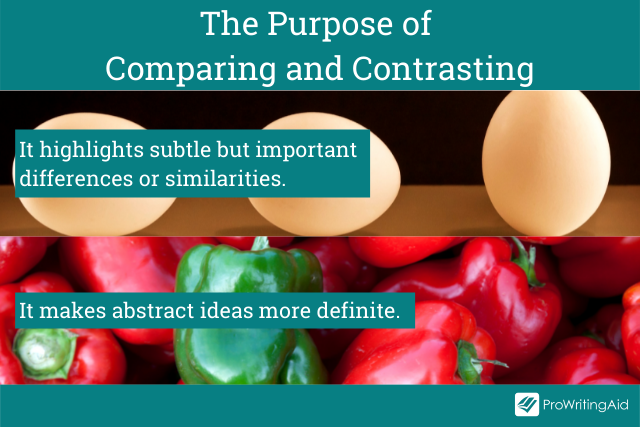
By illustrating the differences between elements in a similar category, you help heighten readers’ understanding of the subject or topic of discussion.
For instance, you might choose to compare and contrast red wine and white wine by pointing out the subtle differences. One of these differences is that red wine is best served at room temperature while white is best served chilled.
Also, comparing and contrasting helps to make abstract ideas more definite and minimizes the confusion that might exist between two related concepts.
Can Comparing and Contrasting Be Useful Outside of Academia?
Comparing enables you to see the pros and cons, allowing you to have a better understanding of the things under discussion. In an essay, this helps you demonstrate that you understand the nuances of your topic enough to draw meaningful conclusions from them.
Let's use a real-word example to see the benefits. Imagine you're contrasting two dresses you could buy. You might think:
- Dress A is purple, my favorite color, but it has a difficult zip and is practically impossible to match a jacket to.
- Dress B is more expensive but I already have a suitable pair of shoes and jacket and it is easier to move in.
You're linking the qualities of each dress to the context of the decision you're making. This is the same for your essay. Your comparison and contrast points will be in relation to the question you need to answer.
Comparing and contrasting is only a useful technique when applied to two related concepts.
To effectively compare two or more things, they must feature characteristics similar enough to warrant comparison.
In addition to this they must also feature a similarity that generates an interesting discussion. But what do I mean by “interesting” here?
Let’s look at two concepts, the Magna Carta and my third grade poetry competition entry.
They are both text, written on paper by a person so they fulfil the first requirement, they have a similarity. But this comparison clearly would not fulfil the second requirement, you would not be able to draw any interesting conclusions.
However, if we compare the Magna Carta to the Bill of Rights, you would be able to come to some very interesting conclusions concerning the history of world politics.
To write a good compare and contrast essay, it’s best to pick two or more topics that share a meaningful connection .
The aim of the essay would be to show the subtle differences or unforeseen similarities.
By highlighting the distinctions between elements in a similar category you can increase your readers’ understanding.
Alternatively, you could choose to focus on a comparison between two subjects that initially appear unrelated.
The more dissimilar they seem, the more interesting the comparison essay will turn out.
For instance, you could compare and contrast professional rugby players with marathon runners.
Can You Compare and Contrast in an Essay That Does Not Specifically Require It?
As a writer, you can employ comparing and contrasting techniques in your writing, particularly when looking for ideas you can later apply in your argument.
You can do this even when the comparison or contrast is not a requirement for the topic or argument you are presenting. Doing so could enable you to build your evaluation and develop a stronger argument.
Note that the similarities and differences you come up with might not even show up in the final draft.
While the use of compare and contrast can be neutral, you can also use it to highlight one option under discussion. When used this way, you can influence the perceived advantages of your preferred option.
As a writing style, comparing and contrasting can encompass an entire essay. However, it could also appear in some select paragraphs within the essay, where making some comparisons serves to better illustrate a point.
What Should You Do First?
Before you compare two things, always start by deciding on the reason for your comparison, then outline the criteria you will use to compare them.
Words and phrases commonly used for comparison include:

In writing, these words and phrases are called transitions . They help readers to understand or make the connection between sentences, paragraphs, and ideas.
Without transition words writing can feel clumsy and disjointed making it difficult to read. ProWritingAid’s transition report highlights all of a documents transitions and suggests that 25% of any sentences in a piece include a transition.

Sign up for a free ProWritingAid account to use the Transitions Report.
So, how do you form all of this into a coherent essay? It's a good idea to plan first, then decide what your paragraph layout will look like.
Venn diagrams are useful tool to start generating ideas. The, for your essay, you need to choose between going idea by idea and going point by point.
Using a Venn Diagram
A Venn diagram helps you to clearly see the similarities and differences between multiple objects, things, or subjects.
The writing tool comprises two, or more, simple, overlapping circles in which you list down the things that are alike (within the overlapping area) and those that differ (outside the overlapping area).
It’s great for brainstorming ideas and for creating your essay’s outline. You could even use it in an exam setting because it is quick and simple.
Going Subject by Subject
Going subject by subject is a structural choice for your essay.
Start by saying all you have to say on the first subject, then proceed to do the same about the second subject.
Depending on the length of your essay, you can fit the points about each subject into one paragraph or have several sections per each subject, ending with a conclusion.
This method is best for short essays on simple topics. Most university-level essays will go point by point instead.
Going Point by Point
Going point by point, or alternating, is the opposite essay structure from going subject by subject. This is ideal when you want to do more direct comparing and contrasting. It entails discussing one comparison point at a time. It allows you to use a paragraph to talk about how a certain comparing/contrasting point relates to the subjects or items you are discussing.
Alternatively, if you have lots of details about the subject, you might decide to use a paragraph for each point.
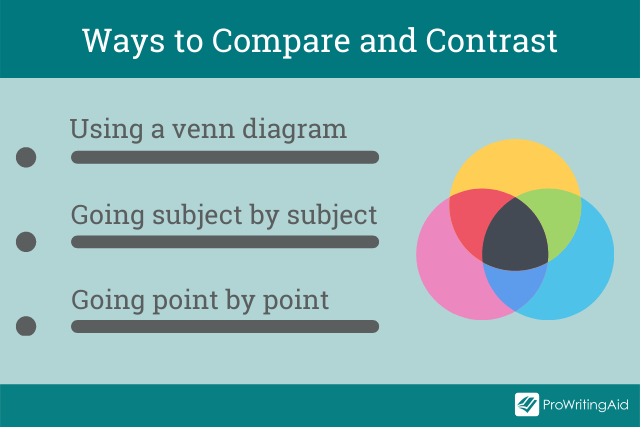
An academic compare and contrast essay looks at two or more subjects, ideas, people, or objects, compares their likeness, and contrasts their differences.
It’s an informative essay that provides insights on what is similar and different between the two items.
Depending on the essay’s instructions, you can focus solely on comparing or contrasting, or a combination of the two.
Examples of College Level Compare and Contrast Essay Questions
Here are eleven examples of compare and contrast essay questions that you might encounter at university:

- Archaeology: Compare and contrast the skulls of homo habilis, homo erectus, and homo sapiens.
- Art: Compare and contrast the working styles of any two Neoclassic artists.
- Astrophysics: Compare and contrast the chemical composition of Venus and Neptune.
- Biology: Compare and contrast the theories of Lamarck and Darwin.
- Business: Compare and contrast 2 or more business models within the agricultural industry.
- Creative writing: Compare and contrast free indirect discourse with epistolary styles.
- English Literature: Compare and contrast William Wordsworth with Robert Browning.
- Geography: Compare and contrast the benefit of solar panels with the benefit of wind turbines.
- History: Compare and contrast WWI to WWII with specific reference to the causes and outcomes.
- Medicine: Compare and contrast England’s health service with America’s health service.
- Psychology: Compare and contrast the behaviorist theory with the psychodynamic theory.
So, the key takeaways to keep in mind are:
Have a basis for comparison. The two things need to have enough in common to justify a discussion about their similarities and disparities.
Don’t go back and forth when using the block method. The best way to write your essay is to begin with a paragraph discussing all the facets of the first topic. Then, move on to another paragraph and talk through all the aspects of the second subject.
You can use both alternating and blocking techniques. Combining the two approaches is also an option. You can apply the alternating method in some paragraphs, then switch and use the block method. This method will help you offer a much deeper analysis of the subjects.
Have a reason for comparing the two things. Only select the points of comparison that resonate with your purpose.
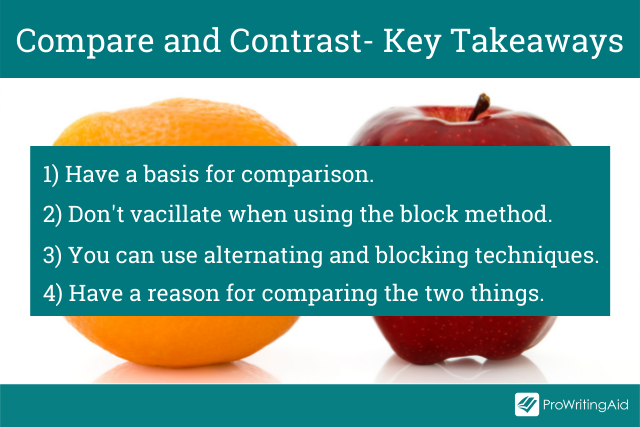
Comparing and contrasting are essential analytical skills in academic writing. When your professor issues you with such an essay, their primary goal is to teach you how to:
- Engage in critical thinking
- See and make connections between words or ideas
- Move beyond mere descriptions or summaries to developing interesting analysis
- Get a deeper understanding of the subjects or items under comparison, their key features, and their interrelationships with each other.
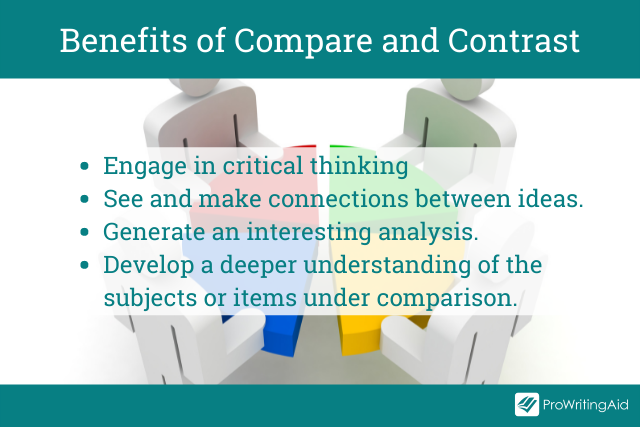
Ultimately, your essay should enlighten readers by providing useful information.
Want to use ProWritingAid with your classroom? Download this free book now:

ProWritingAid Teacher’s Manual
Editing technology like prowritingaid provides immediate, personalized feedback that will help students to better understand grammar and writing techniques., in this guide , we walk you through exactly how to use prowritingaid in your classroom and give you tools and templates for creating a rigorous, effective independent writing practice with your students..

Be confident about grammar
Check every email, essay, or story for grammar mistakes. Fix them before you press send.
Walter Akolo
Walter Akolo is a freelance writer, internet marketer, trainer, and blogger for hire. He loves helping businesses increase their reach and conversion through excellent and engaging content. He has gotten millions of pageviews on his blog, FreelancerKenya, where he mentors writers. Check out his website walterakolo.com.
Get started with ProWritingAid
Visit our Help Center or let's stay in touch via:

IMAGES
VIDEO